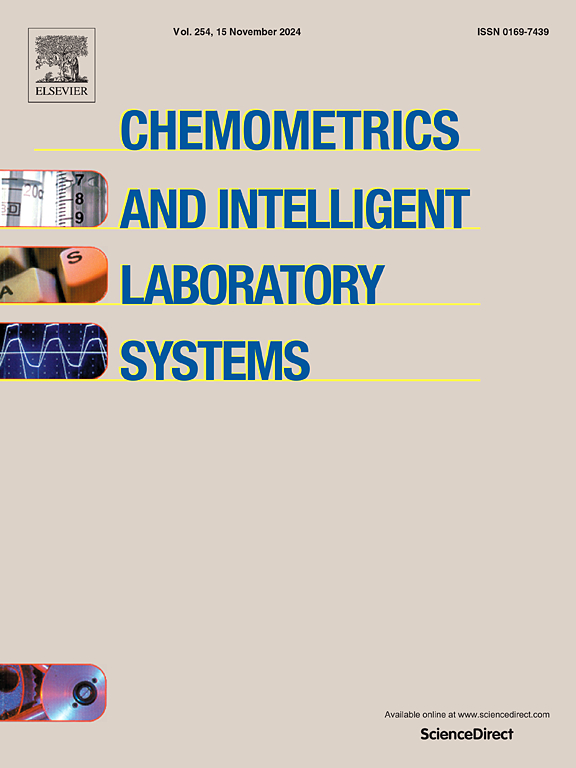Data fusion strategy for rapid prediction of critical quality attributes in JianWeiXiaoShi extract during pulsed vacuum drying process based on FT-NIR and Vis/NIR-HSI
IF 3.8
2区 化学
Q2 AUTOMATION & CONTROL SYSTEMS
Chemometrics and Intelligent Laboratory Systems
Pub Date : 2025-06-03
DOI:10.1016/j.chemolab.2025.105451
引用次数: 0
Abstract
This study explored the feasibility of using two optical sensing methods - Fourier Transform Near-Infrared Spectroscopy (FT-NIR) and Visible/Near-Infrared Hyperspectral Imaging (Vis/NIR-HSI) - to quantitatively predict the critical quality attributes (CQAs) of JianWeiXiaoShi extract during pulsed vacuum drying (PVD) process. Additionally, a data fusion strategy was implemented to integrate the two spectral datasets, aiming to enhance the prediction accuracy and robustness of the quantitative models. Comparative analysis revealed that the FT-NIR model demonstrated higher accuracy in predicting moisture content, narirutin, and hesperidin levels, while the Vis/NIR-HSI model performed better in predicting color changes during the drying process of the extract. In addition to moisture content, the prediction model established by integrating the two spectral datasets through the data fusion strategy demonstrated more accurate predictive performance compared to single-spectrum models. Therefore, integrating FT-NIR and Vis/NIR-HSI spectral datasets through the data fusion strategy for online monitoring of quality changes during PVD of extract represents a rapid, non-destructive, and accurate approach to predict CQAs of materials. This study also provides essential technical support and valuable insights for advancing non-destructive analytical technologies in drying processes.

基于FT-NIR和Vis/NIR-HSI的脉冲真空干燥过程中煎味消湿提取物关键品质属性快速预测数据融合策略
本研究探讨了利用傅里叶变换近红外光谱(FT-NIR)和可见/近红外高光谱成像(Vis/NIR-HSI)两种光学传感方法定量预测建味消湿提取物脉冲真空干燥(PVD)过程中关键品质属性(CQAs)的可行性。此外,采用数据融合策略对两种光谱数据集进行融合,以提高定量模型的预测精度和鲁棒性。对比分析表明,FT-NIR模型在预测水分含量、narirutin和橙皮苷水平方面具有更高的准确性,而Vis/NIR-HSI模型在预测提取物干燥过程中的颜色变化方面具有更好的准确性。除水分外,通过数据融合策略整合两种光谱数据集建立的预测模型比单光谱模型具有更准确的预测性能。因此,通过数据融合策略整合FT-NIR和Vis/NIR-HSI光谱数据集,在线监测提取液PVD过程中的质量变化,是一种快速、无损、准确预测材料cqa的方法。本研究也为推进干燥过程中的无损分析技术提供了必要的技术支持和有价值的见解。
本文章由计算机程序翻译,如有差异,请以英文原文为准。
求助全文
约1分钟内获得全文
求助全文
来源期刊
CiteScore
7.50
自引率
7.70%
发文量
169
审稿时长
3.4 months
期刊介绍:
Chemometrics and Intelligent Laboratory Systems publishes original research papers, short communications, reviews, tutorials and Original Software Publications reporting on development of novel statistical, mathematical, or computer techniques in Chemistry and related disciplines.
Chemometrics is the chemical discipline that uses mathematical and statistical methods to design or select optimal procedures and experiments, and to provide maximum chemical information by analysing chemical data.
The journal deals with the following topics:
1) Development of new statistical, mathematical and chemometrical methods for Chemistry and related fields (Environmental Chemistry, Biochemistry, Toxicology, System Biology, -Omics, etc.)
2) Novel applications of chemometrics to all branches of Chemistry and related fields (typical domains of interest are: process data analysis, experimental design, data mining, signal processing, supervised modelling, decision making, robust statistics, mixture analysis, multivariate calibration etc.) Routine applications of established chemometrical techniques will not be considered.
3) Development of new software that provides novel tools or truly advances the use of chemometrical methods.
4) Well characterized data sets to test performance for the new methods and software.
The journal complies with International Committee of Medical Journal Editors'' Uniform requirements for manuscripts.

 求助内容:
求助内容: 应助结果提醒方式:
应助结果提醒方式:


